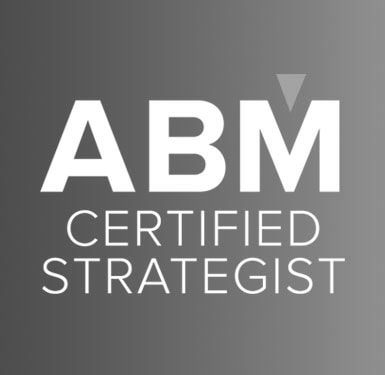High-Performance B2B Digital Marketing Programs and Websites: How to Do More with Less
If you’re reading this, chances are good you’re part of a marketing team in a B2B industrial, technical, life science or manufacturing business. From our experiences helping scores of marketing and sales leaders across multiple B2B industries, we’ve found their marketing challenges and goals to be nearly identical. And that tends to be true whether you’re a niche life science business or an OEM automotive manufacturer.
Today’s B2B marketing professionals are confronting a wide range of challenges, such as too few or poor quality website leads, tight budget constraints, too-many priorities, and what metrics and KPIs to track.
Through a series of comprehensive articles, we’ve compiled information, tips and resources that can help busy marketing leaders like you learn how to navigate the complex landscape of digital marketing, websites and metrics.
The 14 Building Blocks of Modern B2B Marketing
Surprisingly, at many technical companies, B2B marketing practices are still outdated and ineffective. Marketers are overstretched, pursuing too many strategies, communicating with the wrong prospects, and trying to understand a constant deluge of digital tools that promise instant fixes. Yes, with longer buying decisions, more complex B2B products and services, and new digital marketing tools and technologies that pop up daily, B2B marketers in technical companies have a stack of challenges to confront.
Today, there are 14 essential building blocks of modern B2B marketing, and you can use each to grow your business. Each building block helps shape your company’s modern digital marketing program:
- Company website: Your marketing hub and sales team assistant that never sleeps.
- Data-aware: Take advantage of tools that provide essential data such as anonymous visitor intelligence, heat maps and click tracking, email marketing automation, nurture programs, engagement and leads.
- ABM-focused: Identify and focus your efforts on those who represent your best future customers; ICPs, target accounts and industries, and deliver coordinated marketing and sales programs to multiple people on buying committees.
- Connected and integrated: Most marketing platforms are formed by integrating your website with ERPs, CRMs (customer resource management), marketing automation tools, databases and e-commerce platforms, into a hub-and-spoke model.
- Agile methodologies: Often called growth-driven design, agile practices will help you continuously iterate to add to features and broaden functionality based on feedback from users, admins and data. The benefits? You’ll trim your time-to-launch from months to weeks or days.
- Disciplined: Hold regular sales and marketing meetings to evaluate your team’s KPIs, goals and initiatives.
- Collaborative: Sales and marketing teams must constantly be in sync. Good salespeople are always making micro-adjustments to their language when communicating with prospects. Make sure these adjustments are reflected in your marketing content.
- Down to earth: Marketing teams work hard; the days of three-martini lunches are long gone. Today the focus is on down-to-earth things like analytics that provide insight on what your customers want, what works, and what doesn’t.
- Lean: Data and analysis allow us to focus on what matters and cut out the fluff. Cannonballs don’t need to be polished. Lean means focusing on the initiatives that matter the most — those that deliver the most significant value, and promise the highest return.
- Transparent: Your marketing should never present your company as something you’re not. Remember your mission, values and unique value proposition.
- Consistent company identity: Whether prospects experience your brand through a website, sales literature, trade show, or your company lobby, make sure the messaging, tone and design is consistent.
- User-focused: Website users who can’t find what they’re looking for will quickly move on to your competitors. Engage your prospects with informative and educational content that’s easy to find.
- Coordinated inbound and outbound activities: To optimize overall marketing effectiveness, tailor your messages and tactics to appeal to individual personas such as engineers, purchasing managers and senior leaders.
Leading indicator driven: When you focus on a handful of key leading indicators of your sales and marketing activities, you’ll have a clearer picture of your company’s performance.
For more details on each of these essential 14 building blocks read “Website Not Producing Quality Leads? It’s Time to Modernize Your B2B Marketing.”
Complete the form to unlock the white paper and read these additional sections:
I. The Website: Your most important marketing asset
II. Leading Indicators — the top B2B marketing KPIs
III. CRO: Before a website redesign, try conversion rate optimization
IV: The Quarterly Review: Stay on top of marketing and sales performance with continuous improvement
Want to Keep Reading?
I. The Website: Your most important marketing asset
There’s a reason our list of 14 modern B2B marketing building blocks is topped by the website. For nearly all B2B companies we work with, the website is your most important marketing asset.
Because today’s buyers spend so much time on your website, you need a website that’s engaging, educational and informative.
- The site must be intuitive: Confused visitors will not stick around to figure out how to navigate to find what they’re looking for.
- The site must be fast: Users will abandon your website if it doesn’t serve up pages instantaneously.
- The site must be secure: Google bestows higher rankings to websites that carry an SSL certificate. These sites are identified by an “HTTPS” in the url (https://yourdomain.com).
- The site must be mobile-friendly: More customers and prospects than ever visit your website using a smartphone or tablet device — more than 60%. Google also assigns higher authority rankings to sites with responsive designs, which means these sites will rank higher on search engine results pages (SERP).
If site visitors can’t find what they’re looking for, you won’t get a second chance. Therefore, to ensure you don’t lose prospects while they’re engaging your site and other assets, focus on the site’s ability to generate demand, generate leads and focus on retention and recovery. Read more about how to produce quality leads.
But, before you know it, that cutting-edge website you just launched is five years old — reflecting out-of-date product images and content that’s no longer converting site visitors into customers.
To help you maintain a high level of website performance, we believe B2B companies should track eight leading indicators, or KPIs:
II. Leading Indicators — the Top B2B Marketing KPIs
Engagement metrics like bounce rate, time on site and pages per session are indicators that your users may be confused with your content.
Traffic helps you compare returning visitors against new visitors, which is a reflection of user engagement with your content.
Soft conversions such as newsletter or email subscriptions are indicators that your prospects are finding value in your content, even though they may not be ready to buy.
SEO ranking and share of voice vs. competitors help you see how you perform with the keywords you’ve chosen to include in your website content. A tool like Moz can help you compare how your content compares with competitors.
Engagement and conversion rates from PPC campaigns indicate to what degree your target customers notice and click on your ad content.
Open and click-through rates to your website from email campaigns help build up your subscriber base, which over time improves the chances anyone can become a customer.
SEO benchmarks such as page authority, inbound links and relevant page-one keywords are all indicators of how Google sees you. Keep these benchmarks moving “Up and to the right.”
Social engagement indicators such as shares, clicks, and on-site engagement from social media help you grow brand recognition. Look to improve these metrics over time.
For more details on each of these leading indicators, as well as several lagging indicators, read “The Top Marketing KPIs and Leading Indicators For B2B Companies.”
III. CRO: Before a website redesign, try conversion rate optimization
Even the best websites become rusty and sluggish with time. Your once cutting-edge site is now full of out-of-date product images and content that’s no longer producing as many leads. But these symptoms don’t always mean you need to tear it down and start from scratch.
Before you consider redesigning your website and digital marketing strategy, however, we recommend you take your site through a conversion rate optimization (CRO) exercise, first. Through CRO tactics and strategies, you could increase your website’s lead conversion rate. Even a 50% increase — taking it from 1% to 1.5% — could be a big impact. If your company’s average sale is $100,000, that increase translates into an enormous return on marketing investment.
The good news is most B2B marketers could improve their website’s conversion rates without a complete website redesign. The point of smart conversion rate optimization is to NOT spend more money on content, campaigns and new sites. Instead, you make surgical adjustments to your existing website and other marketing tactics that will convert more tire-kickers into buyers and long-term customers.
Here are the top areas to analyze during a CRO review:
Website homepage: Does it offer a compelling position statement that clearly articulates what your company offers and for whom?
Website forms: Make any forms meant for new customers short and sweet. Only add screening questions if you receive too many junk submissions or nuisance inquiries.
Calls to action: What actions do you want your prospects to take after reading your homepage? Ensure the buttons are visible, and you use the same words and design conventions throughout the site.
Content strategy and navigation: Ensure you don’t hide the main (global) navigation within a mobile navigation experience (sometimes called a “hamburger nav”) on a desktop view. Include case studies; write a comprehensive “About Us” page.
Email marketing: Invest in email marketing software that provides A/B testing capabilities, as well as clear metrics for engagement, such as open rates, click-through rates and conversion rates on each campaign. Test your subject lines, send times, and formats to analyze what performs better over time.
Heat maps and click-tracking: These tools give you the ability to see how your prospects are browsing and engaging your content. Identify which page elements attract the most attention and highlight areas that may cause reader confusion.
Improve website load times: Ensure your website is lightning quick. Even though a lot of B2B traffic still comes from desktop or laptop computers, speeding up the experience for mobile traffic matters, and can affect your search engine rankings.
Data-driven conversion optimization: Google Analytics provides you with insights to help you fine-tune your website content. Pay attention to which pages attract the most traffic. Compare bounce rates, average time on page, and exit rates to gauge engagement.
For more details on conversion rate optimization tactics, read “How Conversion Rate Optimization (CRO) is an Afterburner For Your B2B Business.”
IV. The Quarterly Review: Stay on top of marketing and sales performance
When it comes to marketing, the website is your most important asset. But you also have to pay attention to several other areas of your sales and marketing activities, and keep every aspect of the sales and marketing system working together. Consider using the agenda below to guide your review of marketing and sales performance in a quarterly “health” review:
- Website performance: What’s working; what’s not working? Are there pages of the site that are difficult to maintain or edit? Is any language out of date compared with what sales reps are saying to prospects? Which pages have a high bounce rate?
- Sales and marketing: How have your sales and marketing priorities changed since your last review? Have new product or service launches changed the relevance or hierarchy of the content and navigation that you’re presenting to website visitors?
- Strategic business initiatives: What new initiatives or organizational/marketing programs do you have planned for the next quarter? What new content or features will you need to create to support new product launches or sales initiatives?
- Analytics review: Review a simple cloud-based dashboard for insights to guide changes and recommendations. (We like Google Data Studio.)
- Heat maps, engagement and A/B tests: Review heat maps of your top traffic pages, or those most critical to the buying cycle. How are users interacting with these pages? Are they clicking where intended? Do cursor movements indicate interest or frustration?
- Content review: What content is old, irrelevant or thin? What needs to be updated, combined, redirected or removed? What recent work could make a great case study to feature on your site? Are the people featured on your About Us or Leadership pages up-to-date?
- Prioritize next steps: For each assignment or project, document who’s responsible and indicate a deadline. Make goals and next steps SMART (Specific, measurable, achievable, relevant, and timely).
For more details on how quarterly reviews can help you grow, and align sales and marketing, read, “How to Conduct a Quarterly Review of Your Marketing Health.”
More Leads, Higher Quality Leads, and a Growing Business
Creating your digital marketing strategies, improving your company’s website and analyzing overall performance with the right metrics are the three basic steps every B2B marketing leader should take to build a sustainable digital marketing program. When you do, you’ll see results in the form of more leads, higher-quality leads, and an increase in orders and revenue.
As you begin the hard work of creating your high-performance digital marketing program, consider using a planning methodology like the one we use at Windmill Strategy for directing complex projects: Read about it here: “Bringing Order to B2B Website Redesign Strategy & Planning: How to Use the MoSCoW Process.”
Meanwhile, if you’d like help accelerating the growth of your B2B business, let’s talk











